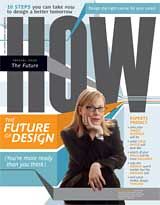Joining me on todays broadcast of Design Matters are four incredible women: Joyce Rutter Kaye, Editor-in-Chief of Print; Michela Abrams, Publisher of Dwell; Barbara deWilde, Design Director of House Beautiful and Laetitia Wolff, Editorial Director of Surface.
Joyce Rutter Kaye has been the editor-in-chief of Print since 2003, after five years as managing editor. As editor-in-chief, she has overseen a complete redesign of the 67-year-old magazine and its website, launched Print’s annual conferences, and created a minor ruckus for publishing a special issue on sex and design. Since Kaye joined Print, the magazine has won two National Magazine Awards for General Excellence and a number of additional ASME nominations. Previously Kaye was managing editor of U&lc, a reporter for Advertising Age/Creativity, and a freelance writer covering design and consumer culture. She lives in Brooklyn with her husband and two sons.
Michela O’Connor Abrams is the President and Publisher of Dwell, the award-winning design and lifestyle media company. In 2006, Dwell hit the coveted Adweek Hot List as well as the Advertising Age A-List, and was a Cappell's Circulation Top Ten Performer for the second consecutive year. In 2005, O'Connor Abrams helped see Dwell to its first major award when the magazine won General Excellence at the National Magazine Awards. She was also honored in 2005 by Media Industry News as Sales Leader of the Year. Prior to Dwell, O'Connor Abrams was the President of Imagine Media’s Business Division, including the flagship publication Business 2.0. She has over 20 years of experience in publishing, trade show management, online branding strategies, and strategic business development. She has also held executive positions at IDG, Ziff-Davis, and McGraw-Hill.
Laetitia Wolff is currently the Editorial Director at Surface magazine, a design and lifestyle bi-monthly, where she is not only spearheading the overall content of the magazine but also leading out-of-the book special projects, such as the Surface Conversation Series. She has been a contributing writer for such prestigious design publications as Abitare, Etapes, Intramuros, [dizajn] and Intérieurs. As founding director of futureflair, inc., a cultural marketing consultancy, Wolff brings extensive experience in the design field and a discerning eye for talent. Focused on a rigorous and creative understanding of design’s cultural implications, she engages in image management, curatorial and editorial development. She is also the editor of Real Photo Postcards published by Princeton Architectural Press. Wolff was the exhibition director and editor of the New York-based Art Directors Club. In addition, Ms. Wolff's experience includes managing the New York studio of renowned Italian designer Gaetano Pesce. She has also worked at the Museum of Modern Art and at Lee H. Skolnick Architects as an exhibition coordinator.
Barbara deWilde is currently the Design Director at House Beautiful Magazine where she has spent the last year redesigning the 100+ year old magazine. She is also runs her own firm, where she creates award-winning work in the music and book publishing industries. Formerly deWilde was the Design Director at Martha Stewart Living magazine. After the successful launch of Martha Stewart Baby and Martha Stewart Holiday, she began working with Hoefler Type Foundry to develop two new fonts for MSL for the re-design of the magazine. Her work for the Knopf Publishing Group, Farrar, Strauss and Giroux, HarperCollins and Little, Brown has been published in Eye, Print, Time, Vanity Fair and I.D. magazines, and selected for display by the Cooper-Hewitt National Design Museum, AIGA, Art Directors Club and Society of Publication Designers.
VoiceAmerica is now the industry leader in Internet talk radio, and Design Matters has over 150,000 listeners. We were also voted a "favorite podcast" on IF's Marketing Podcast survey at www.if.psfk.com, and the show is available as Podcasts on iTunes, where over 45,000 people download the show every month. Last week the show was Number 77 in the Top 100 Business podcasts on iTunes as well as a featured podcast on the site.
Design Matters is from 3-4PM EST and you can view the VoiceAmerica Business site and listen to the show from a myriad of locations:
You can go here, through the Sterling link:
http://www.sterlingbrands.com/ListenLive.html
Or you can go here, through the Voice America link:
http://www.modavox.com/VoiceAmericaBusiness/
Or you can go here, through the Designers Who Blog link:
http://www.designers-who-blog.com
Please note that you will need Windows Media Player or the equivalent program to listen in, but you can download the technology for free here:
http://www.microsoft.com/windows/windowsmedia/download/default.asp
Or finally, you can listen to this show, or any of our previous shows, as a Podcast on iTunes, for free. To listen to the Podcasts, you can do either of the following:
Subscribe manually, by going to the iTunes advanced menu, then select "Subscribe to Podcast," then enter the following:
http://www.sterlingbrands.com/DesignMatters/rss.xml as the feed.
Or simply do a search on the iTunes music store Podcast directory for “Design Matters.”
Everyone is welcome to call in live and toll free--the number is 1.866.472.5790.






















